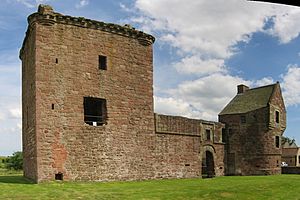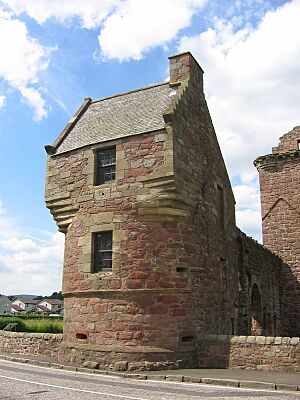Burleigh Castle facts for kids
The remains of Burleigh Castle are found near the village of Milnathort, about 1.5 miles north of Kinross, in Perth and Kinross, Scotland. This old castle was built in the 15th and 16th centuries. Today, it stands next to the A911 road.
Contents
History of Burleigh Castle
Early Owners and Royal Visits
The Balfour family owned the lands of Burleigh starting in 1456. King James II gave the land to John Balfour of Balgarvie. A strong tower house was built here in the late 1400s or early 1500s. Later, Sir James Balfour of Pittendreich made the castle bigger. He added a strong outer wall with a tower at the corner, plus other buildings.
Burleigh Castle was a handy place for important people to stop. Mary of Guise, the mother of Mary, Queen of Scots, had dinner at Burleigh in 1540. She was on her way to Falkland Palace. King James VI of Scotland also visited often. He stayed there in January 1589 and again in July 1596.
In 1592, Colonel William Stewart was held at Burleigh Castle. People thought he was planning to help the Earl of Bothwell try to capture King James VI.
The Balfour Family and a Famous Escape
In 1607, Michael Balfour was given the title of Lord Balfour of Burleigh. This made him a very important person.
There's a famous story about Robert Balfour. Before he became the 5th Lord, he was sentenced to a very serious punishment in 1707. This was because of a dispute involving a schoolmaster in Inverkeithing. Robert Balfour managed to escape from Edinburgh's prison!
After his escape, Balfour joined the Jacobite cause. The Jacobites supported James Francis Edward Stuart, who they believed should be king. Balfour even declared James Stuart as king in Lochmaben. He then fought in the 1715 uprising. After the Jacobites lost, Balfour lost his titles and lands. He died in France in 1757.
Later Owners and Modern Times
The castle was then taken over by the Irwins, and later by the Grahams of Kinross. Today, Burleigh Castle is a Scheduled Ancient Monument. This means it's a very important historical site. It is looked after by Historic Environment Scotland. There is no charge to visit, and you can get the key from a nearby house.
A local poet named Michael Bruce was inspired by Burleigh Castle. In 1760, he wrote a poem called "The Lovers." It tells the story of Henry and Harriet, who were from two feuding families. They supposedly ran away to Burleigh Castle.
What the Castle Looks Like
The castle remains show the western part of what was once a square courtyard. This courtyard was called a barmkin.
The Tower House
In the north-west corner, you can still see the original tower house. It is mostly complete and stands three storeys high, plus an attic. The walls are about 5 feet (1.5 metres) thick. They rise up to corbels, which are stone supports. These corbels once held up a walkway around the top of the castle. The roof and inside floors are now gone. However, the vaulted basement, which has a curved ceiling, is still there. A spiral staircase in the north-east corner once led up to a small room on the roof. This room gave access to the walkway.
The Corner Tower and Walls
To the south-west, there is a 16th-century corner tower. It has two storeys above a basement and still has its roof. The tower is round at the bottom. It then widens out to a square upper storey. This tower is a beautiful example of Scottish baronial architecture from that time. Its stone work is very well preserved.
Both this tower and the main tower house have gun loops near the bottom. These small openings were for firing guns to stop attackers. The corner tower also has tiny round pistol-holes higher up. These might have been for decoration as much as for defence. On the north side of the tower, you can see the date 1582. There are also the initials IB and MB, which stand for Sir James Balfour and his wife Margaret.
The two towers are connected by a section of the outer wall. This wall has an arched gateway. Although it's just a stone 'skin' now, this wall once had a two-storey gatehouse behind it. This wall shows how detailed and refined the architecture was for its time in Scotland. A defensive moat, a ditch filled with water, might have surrounded the castle courtyard in the past.



